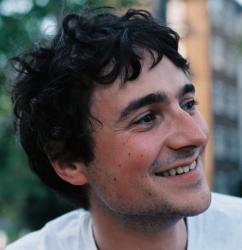In the darkness, light. A flickering fire illuminates a pitch-black hut; an infant sits by it, his bulbous head tracking the sparks as they rise to the ceiling. When the flames die, his survival instinct leads him outdoors in search of firewood. Thus begins Child, a remarkable student film from Iring Freytag and Viktor Stickel, that traces a life cycle in nine swift, sober minutes.
Animation is well suited to depicting an entire lifespan – for one thing, there’s no discontinuity between actors of different generations – and the womb-to-tomb short has become something of a genre. Filmmakers have approached the subject in various ways: Mikey Please’s The Eagleman Stag focused on the anxiety of passing time, while A Single Life, by Job, Joris and Marieke, generated absurd humour by cutting at random between scenes from a woman’s past, present and future.
In Freytag and Stickel’s (with input from Linus Stetter) Child, ageing is portrayed as a natural process, almost mystically in sync with the elements. The child emerges into a white landscape where the only other sign of life is a forest of alien trees. He proceeds to uproot these one by one, growing into robust adulthood as he does so. By the time the whole forest is felled, he has entered old age. As he struggles to carry the wood home, ashen snow begins to fall, recalling the rising sparks of his childhood. Black comes to dominate the frame once more, bringing the film full circle.
The story has a fable-like simplicity (it unfolds like a negative image of Frédéric Back’s classic The Man Who Planted Trees). An environmental message is suggested, but not hammered home. The film essentially consists of just one scene: edits are discreet, and the character grows before our eyes. The absence of dialogue—all we hear are sound effects and glassy ambient music—lends it a universal appeal. Freytag and Stickel made Child at Germany’s esteemed Filmakademie Baden-Württemburg, while studying under master minimalist Andreas Hykade; their film is beautifully economical in its own right.
This extends to the stark monochrome palette. The character and trees are sketched in black woodcut-style lines, and the barren surroundings are evoked in blank backdrops. To bring Tobias Trebeljahr’s gorgeous 2D concept art to life, however, Freytag and Stickel turned to cutting-edge 3D technology. “Our challenge was to create a handmade look without drawing a line ourselves,” they explain. Child was animated using the Maya software; the final look was mostly created in the compositing stage. Ink was added to the backgrounds for texture, but the film was otherwise made entirely digitally. This approach allows for dynamic camerawork and aids the character’s seamless transition between ages, without compromising Trebeljahr’s aesthetic.
I first saw Child at a festival, halfway through a programme of flashy, dramatic shorts. Its steadiness and narrative clarity bowled me over. It avoids the common vices of student films – awkward pacing, on-the-nose messages – and I took it to be the work of veteran animators. Luckily, Freytag and Stickel are not yet far advanced in their own life cycles. While freelancing as 3D character animators, they are looking to assemble funds for a new film. Fingers crossed.

 Alex Dudok de Wit
Alex Dudok de Wit